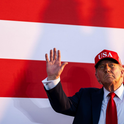Americans have had a bumpy summer. Donald Trump continued to make incoherent pronouncements about a Covid-19 crisis that has not been controlled. There appeared to be no relief in sight for a cratering economy. The big racial justice protests, triggered by the killing of George Floyd, were met with unlawful arrests in Portland, Oregon; and parents were gripped by anxiety about whether to send their children back to school, amid alarming infection numbers in Texas and Florida and through the Midwest.
Some Americans tell themselves that the answer to these worries lies in the presidential election on 3rd November. That was the message of the (virtual) Democratic National Convention in August: Vote. Vote. Vote. The hope is that an overwhelming victory for the Democratic candidate Joe Biden will magically resolve the uptick in racial and economic tensions, help regain control of the virus and restore normalcy.
But that hope assumes that “voting” and “elections” and “turnout” and “polling” mean in 2020 what they used to mean. And in the Trump age, we have learned that old ideas, presumptions and legal norms can no longer be relied on. In reality, the notion that one casts a ballot and that this ballot is automatically processed, counted and registered such that all votes count equally, was always magical thinking. If you are African American, it was probably never true; come November, it may also prove to be untrue if you are elderly, or a student, or high risk for Covid-19, or live in a Democratic stronghold. It’s tempting to wade into psephology: could the new barriers facing older voters, who may be more conservative, offset the obstacles put in the way of racial minorities casting a ballot? But this is a distraction from the gravest danger for the system (and greatest opportunity for a president languishing in the polls). Namely, that everybody will feel cheated.
Because if the system doesn’t treat your vote fairly, will you know about it? And what—if anything—can you hope to do if it doesn’t? How will we collectively ever know if voters were treated so unequally that the 2020 election was invalid? What could be done to remedy it then? And just how bad could it get?
November 2020 will not be the first national contest to expose the reality that democracy plays out within a framework of law and powerful institutions. The knife-edge 2000 election was marred by poorly designed ballots and malfunctioning voting machines in Florida, the state that proved pivotal to the nail-biting national outcome. Networks that had called the election for Al Gore based on exit polls were forced to recant, and then Florida’s Republican secretary of state called Florida for George Bush. Gore phoned Bush to concede, then—as the margin tightened—called again to take it back. Operatives from both parties swarmed the state. Democrats filed suits to demand recounts in certain precincts; Republican state officials moved to stop them. With the clock ticking down to the January transition, a line was drawn under the sprawling affair only when the Supreme Court ordered that the recounts be halted and found that no recount could be done in a timely fashion. The legal theory was incoherent, arriving in an unsigned opinion that precluded future courts from relying on its reasoning, and its 5-4 vote pitted conservatives against liberals, but it was enough to make Bush president. Still, the authority of the court wobbled, and the nation barely survived the trauma.
There are myriad reasons why November 2020 could be far worse. Despite bipartisan efforts to correct the system after Bush v Gore, for the most part the US still depends on the same rickety, decentralised, underfunded voting system. State and local governments pride themselves on administering elections with different rules, voting apparatus and standards. There is no single federal election but, rather, thousands of local elections, administered by elected (and partisan) state officials. The courteous octogenarian workers who usually staff the polling stations may not show up in the year of coronavirus. Laws about absentee voting, voting by mail and voter identification differ by region. Some precincts continue to rely on outdated voting machines, the source of those infamous half-punched marks that became known as “pregnant” or “hanging chads” in the 2000 Florida recount.
The pandemic dramatically adds to the mayhem; it remains rampant in many of the states that will—through the electoral college—play a determinative role in picking the next president. There is an overpowering public health need for adjustments to the ordinary processes that can involve waiting in long queues, and most urgently for vulnerable citizens to be guaranteed easy access to postal votes. But there is also an overpowering will, in the Oval Office, to see that this relief is not provided. There is also a Supreme Court tradition that forbids changing election rules close to an election that militates against such relief, despite the pandemic.
[su_pullquote]“How will we ever know if voters were treated so unequally that the 2020 election was invalid?”[/su_pullquote]
The Wisconsin Democratic primary in April 2020 was a dry run for what could fail in November. A Democratic governor’s moves to modify the voting procedure and timetable were obstructed by the Republican state legislature and partisan state jurists. The fall-out of that contest included: mail-in ballots that never arrived; court efforts to ease voting restrictions; and an 11th-hour emergency determination by the Supreme Court that such efforts were unlawful.
Ominously, this past summer the most conservative Supreme Court in a century has weighed in on multiple state voting regulations, some of which would make voting easier in a pandemic, and on every occasion it has come down against broad expansions. These rulings are often cursory and swift. The aggregated result is that state efforts to make it easier for vulnerable voters to register and cast ballots are rebuffed.
Then there is the president. In July, Americans in some states faced power cuts and long delays in Covid-19 test results, which fuelled anxiety around elections and spurred the skyrocketing requests for postal ballots. Donald Trump—ever eager to inject uncertainty and controversy—began to float the idea of delaying the election. (He cannot.) When that met with resistance, he suggested declaring any result invalid if voting was conducted by post. In-person voting itself is also under threat, with polling stations closed, voter rolls purged and identification rules tightened. There are threats of (sometimes armed) “poll watchers” who will intimidate prospective voters. And some fretful Americans are hearing that there’s no point in trying to cast a ballot, which is precisely the message this president—who lost the popular vote by almost three million in 2016—has been promoting since the last presidential election, when he claimed that if defeated he would not necessarily concede.
In addition, the president’s Postmaster General Louis DeJoy, a campaign contributor with asset holdings of between $30.1m and $75.3m in postal service competitors, launched a reorganisation effort in August that will slow the post, and make voting more costly, just in time to gum things up. The post office issued warnings that it could not guarantee that postal ballots would arrive in time to be counted, including those posted by state deadlines. Trump weighed in: “These ballots are going to be lost. They are going to be gone.” He admitted that he opposed additional post office funding because “that means you can’t have universal mail-in voting because they’re not equipped to have it.” Some of DeJoy’s worst efforts to slow down the mail have been reversed, but other “fixes” he implemented have not. The net effect is that millions of voters have been warned that their ballots will not be counted, and—sure enough—reports began to emerge from election officials about worried questions, and in some cases cancellations, from voters who had previously made requests for postal ballots. The president continues to claim that any election with large numbers of them will be rife with fraud, and may need to be rerun.
And while Americans are realising that it may take days or weeks for every ballot to be counted, and that news readers may not be calling the result on election night, the president is both ramping up expectations of chaotic delay, claiming that the result will not be known for “months or even years,” and—at the same time—insisting that the election must be decided on the evening of 3rd November or it will be presumptively invalid. If he succeeds in making voting by post a marker of effete liberalism, perhaps his own supporters will be more likely to vote in person. And if in some places in-person ballots are then counted first, it becomes easy to imagine him being ahead on the night in states where he would ultimately be destined to fall behind. That could be useful. Of the many frightening scenarios to contemplate, one is that Fox News may simply call the election for him regardless of where the actual outcome is headed.
Together, these issues—plus the vagaries of ongoing state-by-state litigation over voter IDs, felon disenfranchisement and more—means that the 2020 election will be akin to a game of whac-a-mole. Trouble is bound to pop up in some places, and if—a big if—it is a rout nationwide, there will be doubters who disagree with those Americans who believe it occurred legitimately. Voting rights advocates and election lawyers might hope to stave off particular legal abuses or crises in this election, but none of these is likely to do as much damage as the uncertainty injected into the system by the president and his enablers. The contemplated fixes are legal, mechanistic and process-oriented. But if the last few years have taught us anything, it is that power-hungry cynics can render such guarantees into empty words.
In the words of the recently arrested former Trump strategist Steve Bannon, one need only “flood the zone with shit” in order to confuse everybody and rile up partisans. No matter what kind of disaster planning you might try, yet another electoral catastrophe seems to lurk around the corner. All manner of administration actions could whip up so-called “October Surprises” intended to skew the election—from an expected Justice Department report on unlawful conduct by Joe Biden’s son Hunter, to some kind of federal crackdown on speech or protest tied to Black Lives Matter—any of which could sharply raise the temperature. At any moment, a chaos president can declare something an “emergency” and myriad powers become his to deploy.
Citizen confusion, as opposed to more direct meddling, is also the object of foreign interference efforts in the November election, interference that has been confirmed by US Intelligence officials, time and again, but never addressed by the Trump administration. All this distrust and fear adds up to an electoral nightmare, and an American election machine that has operated largely on principles of trust and good faith is not equipped to respond in real time. Those who study the deaths of democracies warn that this confusion and mistrust is the real work of tyrannical forces: they foment uncertainty in the media, in science, in truth and fact. The seeds of this effort have been sowed since Trump took power.
In the face of the confusion, it is tempting to head down a wormhole of legal, constitutional and statutory indeterminacy. What happens if a swing state cannot certify an election result? Could Trump succeed in pressuring Republican-controlled legislatures to ignore the popular vote (primarily in Michigan, Pennsylvania and Wisconsin) and instead select an electoral college slate that supports him? What happens if there is a tie in the college vote? What happens if insufficient properly certified college votes come in on time to provide either side with the requisite majorities, and it’s then left—as per the constitution—to the House of Representatives to pick a president? A nightmarish twist for the Democratic side hoves into view here, since although the party controls the House overall, the constitution specifies that in this one scenario there is only a single vote from the delegation from each state, however sparsely populated, which could give Republicans the edge. No wonder some Democrats are swotting up on the ground rules, and asking how they could respond in kind, in a prospective game of “constitutional hardball.”
But there is also a more fundamental set of questions about what happens if the president refuses to concede defeat. Conversations in that key that seemed fanciful a year ago, about military intercession in a contested transition, are now commonplace.
A look back at 2000 serves as a useful corrective to any thinking that this will be tidily resolved in the courts, the press or the public square. That election established that premature declarations of victory can create momentum that’s hard to defy; and premature concessions (like Gore’s) create problems. Neither side will fold in 2020 if the result is in any doubt whatsoever—indeed, Hillary Clinton has advised Biden not to concede in “any circumstances.” Both camps will lawyer up, declare victory and posture. Both are already floating “taking to the streets” as a way to shore up their interpretation.
[su_pullquote]“One frightening scenario is that Fox News simply calls the election for Trump regardless of where the outcome is headed”[/su_pullquote]
Besides, a fractured media—these days rife with foreign misinformation and new media companies with no interest in the truth—means that there may be no moment in which the bulk of the country will witness anything like, say, a Gore concession or a Bush acceptance. However weak its case may be, each side can continue to contest the election for weeks, certain that it will receive a favourable hearing at least in the partisan media.
In 2000, Gore edged out Bush in the nationwide poll, but only by a mere 500,000 votes, and much of the public only vaguely understood the anti-democratic potential of the electoral college system, which had not before that point fallen out of kilter with the popular vote in over a century. But having witnessed such a divisive figure as Trump secure a materially smaller number of votes and yet still win in the college, the American public is less sanguine about a system that was designed by the Constitution’s framers to preserve minority power. A pro-Republican gap between the nationwide vote and the college is becoming more of a feature than a bug; and if it once again makes the difference, many of Trump’s enemies may regard the election as invalid.
To stand any chance of finding a way through such chaos, the political system stands in sore need of a trusted referee—respected by all sides. But we have also witnessed a federal judiciary, helmed by Chief Justice John Roberts, the court’s current “swing vote,” that has long been almost fanatically opposed to efforts to protect a free and fair franchise. It was, after all, the Roberts court that in 2013 voted to cut the heart out of the civil-rights era Voting Rights Act. It was this same court last year that declined to alleviate extreme gerrymandering that lets small minorities of voters elect the bulk of their state legislatures. Such judgments came before this year’s rulings against state efforts to help sick and elderly voters participate via curbside voting or simplified registration, and were made despite the lack of evidence of widespread voter fraud in America, and irrefutable evidence that vote suppression has been a longstanding Republican tactic.
We forget now that when the US Supreme Court handed down its decision in Bush v Gore in December 2000, there was already a genuine question about whether the American public would tranquilly accept an opinion finding that the Florida recount needed to be stopped, on a legal theory that was expressly never to be used again, to the benefit of Bush. That the public did so was, in no small measure, a testament to the authority of the federal judiciary to resolve issues in ways that at least appeared to be rooted in law, not politics. Among the bulk of the electorate, including quite a lot of those who had voted against Bush, there was an underlying respect for the highest court in the land.
Trump has harmed that basic confidence by using his time in office to demean and attack the federal judiciary. At the same time, he has packed the federal bench (making 200-plus appointments in four years) with young and unqualified nominees, some of whom have never seen the inside of a courtroom, and presided over the toxic confirmation of Brett Kavanaugh, a man credibly accused of assaulting a teenager at a high school party, to the Supreme Court. He delegitimises the very notion of an independent, apolitical judiciary that answers to the constitution and the law, and politicises the judiciary that actually exists. By insulting lifetime-appointed judges who disagree with him, he hopes to cow independent jurists into silence and embolden his new generation of placemen to assert themselves on contested aspects of the election. Having a Supreme Court comprised of five staunch conservatives—two of whom he appointed—will give him a good chance of prevailing in a Trump v Biden lawsuit, if and when it comes before the court in 2021. And if the potential case is just too weak to carry this court, he has already prepared the political ground for attacking the ruling, by trashing the judicial branch as a whole.
[su_pullquote]“Well in advance, many fear this election has already been stolen. That was always the plan”[/su_pullquote]
The deepest worry, though, is not about any single part of the election machinery—the newly-partisan media, the newly-demeaned courts, the stubbornly unfixed voting machines—but faith in the whole system. When Trump tweets that the 2020 election will be “stolen” or that voting by mail (something he has himself done in the past) is inherently fraudulent, or when his postmaster general slows the mail to a crawl, or his administration rigs the census to undercount minorities, or his attorney general persists in investigating Trump’s opponent, then, yes, he creates daily headlines. But the real project is to discourage voting. These mini-dramas combine to achieve the singular end that has been Trump’s aim from the start, and the purpose of autocrats everywhere: to erode public certainty that elections themselves are legitimate.
The real difference between the election of 2000 and the election of 2020 is that in 2000—bearing in mind a centuries-long history of voting irregularities and suppression, and a system of campaign finance that helps no one but plutocrats—the voting issues that proved decisive could be written off as a one-off. The issues with voting machines looked technical, and small, and maybe silly, and could be understood by supporters of both parties as a fluke, a once-in-an-epoch twist of fate, that just happened to affect the nation’s most pivotal voters, and thereby leave five conservative Supreme Court jurists holding the keys to the White House. Thanks to a shared understanding that the root problem here was a design flaw, a technological accident, the problem could ultimately be addressed—even if badly, even if in hindsight, even by way of a partisan Supreme Court—without rupturing the foundations of the political system.
But this is not Florida, and this is not 2000. Voters may need to stand in line for hours in the cold amid a second wave of the virus, machines may again malfunction or conceivably be hacked, the power grid may flicker, or mail-in ballots may be discarded (or not) and nobody will know. Nor is anybody going to believe that any trouble is just accidental. A public that has descended into acrimony over simple science-based questions such as wearing masks and getting vaccines may feel that it doesn’t need to wait and see how the election fails; many will suspect that months before it has taken place, the election had already been stolen.
Trump has been setting up that claim for four years. His followers already agree. His opponents also agree. The 2020 election may play out without interference or glitches, and the results may still satisfy nobody. As the Buddha said of the shattered bowl, it was already broken in the first place. Because this election was never really about ageing election machinery or the state-by-state rules around voting by mail. It was about public trust in a clunky system of rules, norms and statutes—trust which appears to already be gone. That was the danger of pitting Americans against Americans. And that was, of course, always the plan.












